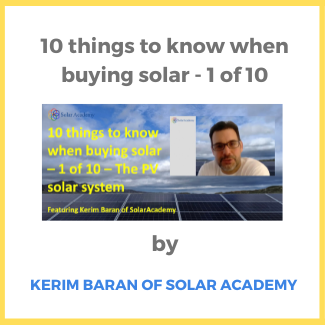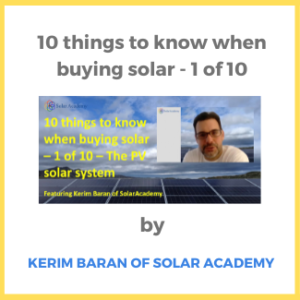In this first video in a ten-part training series of key concepts for people looking to buy a solar system, Kerim Baran of Solar Academy describes the basic components of a rooftop solar system. Part of his discussion includes a description of the typical system size/wattage generated. The 2-minute video and transcript are below. The entire series can be viewed here.
Here is the transcript of the video:
Kerim Baran: I’ve developed a 10 concepts video training for people who are looking to buy solar for their home. The first concept is the actual photovoltaic solar system. So what makes up a solar system? A photovoltaic solar system for the home is not to be mistaken with a solar thermal system which is to heat water. The photovoltaic solar system generates electricity.
Did you know what the average size of a solar photovoltaic solar system is in kilowatts? Generally speaking between six and eight kilowatts and each panel use to generate around 200-250 watts so that would mean four 250-watt panels would make one kilowatt. So a six-kilowatt system would mean 24 panels. Nowadays the panels are now reaching 350-400, even 500-watt sizes so let’s just assume a 400-watt panel to get a 6-kilowatt system you need about 15 panels. But that’s just one of the main components.
Another key component is the inverter, and inverters can be either string inverters which means one big boxy thing you can generally put on the wall of a garage and tie in all the panels to. Or it could be micro inverters, one for each panel and then the rest of the system is mainly racks and mounts that would tie the system to the roof. Then also wires and connectors and disconnects which is usually called the balance of system. And then of course there’s the battery for backup systems and other arbitrage users, which is becoming more and more popular. It didn’t use to be that popular over the past decade.
So those are the main components of a photovoltaic solar system.


